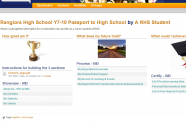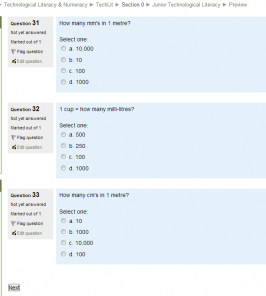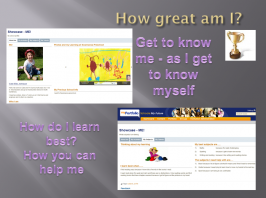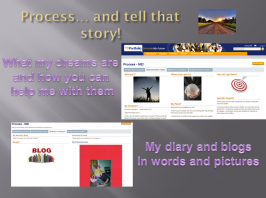Documenting progression from primary to secondary school
Coherent curriculum: Seamless transitions
Passport to high school is an innovative solution to documenting progression. Students create and maintain an e-portfolio of their understandings and achievements. The initiative was developed as part of Rangiora High School’s successful drive to raise student achievement in technology in years 9–13.
This teaching snapshot is an example of assessment for learning.
Raising student achievement
In recent years, Rangiora High t teachers have worked together to restructure their programmes and that the t learning area is fully implemented in years 9–13. The teachers tweaked the years 9–10 programme so that students were covering all eight components over a year. They considered how they could raise achievement at all levels. Every year, year 9 teachers spent valuable classroom time working out what t knowledge and skills their students had brought with them to high school. These teachers often found that the students' understanding of technology knowledge was not at the expected .
is a core subject at years 9–10, with students electing which area of t to study. Due to inconsistencies in prior and experience, many students dropped t at this stage. Catherine Johnson (Head of Faculty, t says senior teachers were “pushing uphill” to cover the their students needed but hadn’t always grasped thoroughly in the limited time available in years 9–10. NCEA results were mostly at Achieved , and student numbers shrank in years 12 and 13 because of the degree of difficulty involved in successfully completing year 11.
Catherine comments that “teachers here were exhausting themselves preparing their seniors for NCEA and I thought this was something that needed to be reversed. To make it easier at senior , we needed to focus on the juniors and put more pressure on the curriculum design in years 9–10.”
Junior t pre-test
Y9 Lit & Num test-1 (PDF, 191 KB)
Y9 Lit & Num test (Publisher, 230 KB)
With a year 9 programme established to coverage of all eight components, the team next looked at progression. They introduced a year 9 pre-test, to assess students’ understanding of generic . They were supported in this by senior management. A time was made available in the first week of Term 1 for all year 9 students to sit the test. The 50-question, multi-choice test identified what students knew and the they were working at. It gave teachers a good indication of the they needed to introduce or reinforce during the year.
The pre-test was followed by a post-test at the end of the year, again done by all students at the same time.
With a good understanding of what their junior students already knew or needed to know, teachers put more pressure on them during the year. Rangiora High has a Junior graduation system, with students being assessed in each subject. The teachers could use this challenge as incentive to push their students to achieve. “The system acts as a preparation for NCEA’s strict compliance standards.”
Collaboration with local primary schools
With the pre-test established as a way to support student progression into years 9–10, the next step was to look at how to improve student achievement in the progression from primary to secondary school. Rangiora students come from 21 contributing schools, with about 50% taking t at the Rangiora Borough School Technology Centre. In previous years, a Rangiora High/contributing schools network had been set up to create a closer relationship between all the schools. Years 7–8 teachers had come to the high school for regular meetings and collaborated on course outlines and direction of learning.
The existing relationship between the local schools provided a base for the team to collaborate with their primary school counterparts. Catherine approached Rangiora Borough School first. She gave teachers the results of the year 9 pre-test to show how their students rated against the whole year 9 cohort. She discussed the years 9–10 programme. She learnt about what the years 7–8 students were being taught. Catherine next visited the 21 contributing schools.
Staff from the Centre also attended professional learning development sessions on assessing to New Zealand Curriculum s, held at Rangiora High. “This was very beneficial to boths of staff. We realised that in about 80% of our classes we were doubling-up on some aspects that had already been done in years 7–8. Now, when we ask if students have done a particular project and nobody puts their hand up, we can say ‘But I know you did this in years 7–8.’ There’s no easy ride for them anymore!”

Sharing the year 9 pre-test enabled the primary teachers to see the specific that high school teachers were expecting their students to know, and any gaps that needed to be filled. The high school digital, processing, and materials (resistant and textiles) teachers also “buddied up” with their equivalents at Rangiora Borough School, sharing what they were doing and keeping in email contact. Catherine says the visits and sharing of information helped the collaboration between schools, but the driving force behind pulling them all together was the introduction of the Passport to high school initiative.
Coverage map with the revised technology learning area technological areas:
Blank learning area coverage resource (PDF, 76 KB)
(Resource from Kia Takatū ā-Matihiko, national digital readiness programme.)
Passport to high school
Rangiora High deputy principals had approached Catherine about creating some kind of formal evidence to show student progression to high school.
“They asked me, as a teacher, how we could bring together every aspect of a child’s learning from years 1 to 8 so that they could bring it with them to high school, instead of starting afresh. As we’re often reminded by our DP in charge of curriculum Brian Hays, ‘It should be the ninth year of learning, not the first year of high school.' "
Catherine Johnson
Catherine suggested an e-portfolio for students – Passport to high school. This would contain three sections:
- Showcase – copies of school awards, sports certificates and other achievements.
- – events, new learning, new opportunities, on-going thinking and ideas, blogs, journals, and dreams.
- Accountability – information from parent-teacher interviews, school reports, and reading age.
Each section would also include sub-categories. The process section, for example, would include pages on "The way I learn" and "The way I want to be taught."
Success
After showing year 8 teachers the year 9 pre-test the previous year, the results for the next year showed a jump in and understanding up to one . With the cooperation between schools in setting students up for year 9, followed by teachers pushing them harder than in previous years, students are not only achieving more in but enjoying it more. There was a “massive increase” in the number of students opting to take in year 10, and a subsequent increase in teaching staff.
After just one year of focusing on junior classes the improved s of student achievement and engagement were showing through in Year 11 NCEA results, with increased Merit and Excellence endorsements.
The Passport to high school was a great success in the collaboration with Rangiora Borough School and others, says Catherine.
“Rangiora Borough aligned their strategic plans, assessment, and reporting to our systems, and their teaching and PLD strategy, so that progression could continue in year 9 rather than starting over."
Catherine Johnson
Belinda Turner from Rangiora Borough School has this to say about the collaborative effort.
"Although we felt confident we were treading the same pathways as our high school colleagues this initiative has opened windows of for us. We have been invited to take part in PLD and visit the high school to see first hand what they and their students are achieving. We have also made a commitment to strengthening our dialogue with our contributing schools. We plan our programmes with the that we are minimising the chance of double up and crossover. We have refocused our learning and clarified the achievement s within our Centre. We still have a way to go as our focus has been on the years 7–8 students who attend the Centre. We still have a more distant relationship with the programmes running through our school. We feel that we have developed in confidence with complying to the curriculum document and with the development of our programmes.
Belinda Turner
When asked what was great and what was challenging about this initiative, she replied:
"The that we have the support of Catherine and her colleagues is fabulous. It can be challenging to make change especially if it's hard to fathom the intended , which is where having the support of like-minds is invaluable. Keeping the dialogue ongoing is a challenge with everyone leading busy lives and coping with the demands of the profession. Also keeping the 'faith' was important. We all knew we were doing a sterling job and wanted to retain the good strong points without losing the relativity. Call it professional vanity but sometimes it's best not to 'chuck the baby out with the bath water.' In saying that though, we have reviewed, adjusted, and redirected our teaching and programmes with this initiative and as educationalists we are always aware that our own learning has to be open to further growth."
Belinda Turner
When asked about any future directions this make take, she answered:
"We would like to see a continuation of the relationship and a stronger collaboration with planning. We can see the benefits that a years 7–10 programme offers students and teachers. Maybe the development of a years 7–10 learning environment could lift achievement further. We would also like to have our secondary colleagues visit us and see us in action so that they may in turn see how their programmes could grow. Literacy is a great word and no doubt it will continue to dictate the shape of our future – however, it needs to be in a shape that is relative to the students' understanding."
Belinda Turner




